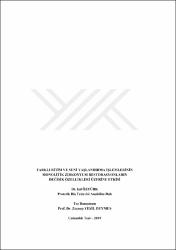| dc.description.abstract | Amaç: Bu çalışmanın amacı, monolitik zirkonyum restorasyonlara uygulanan bitim ve suni yaşlandırma işlemlerinin yüzey pürüzlülüğü, topografik özellikler, faz değişimi ve bükülme dayanımına etkisinin incelenmesidir. Materyal ve Metot: Disk şeklinde 100 adet monolitik zirkonyum örnek, presinterize monolitik zirkonyum bloklardan (Ceramill; Amann Girrbach GmbH) sinterleme büzülmesini karşılayacak şekilde hazırlandı. Üretici firmanın talimatları doğrultusunda, 1450 °C'de 7 saat sinterlenme işlemine tabi tutulduktan sonra 15 mm çapında ve 1.2 mm kalınlığında örnekler elde edildi. Örnekler, glaze işlemi uygulandıktan sonra rastgele beş gruba (kontrol, A, AP, AG, APG grupları) ayrıldı. Kontrol grubundaki 20 adet örneğe herhangi bir işlem uygulanmadı. Grup A'daki 20 adet örneğe glaze işleminden sonra mavi bantlı elmas frezlerle aşındırma işlemi, Grup AP'deki örneklere grup A prosedürü sonrası zirkonyum polisaj seti ile polisaj işlemi yapıldı. AG grubundaki 20 adet örneğe aşındırma işlemi yapıldıktan sonra tekrar glaze işlemi uygulandı. Geriye kalan 20 adet örneğe (Grup APG) Grup AP prosedürü sonrası glaze işlemi uygulandı. Tüm gruplar iki alt gruba (n=10) ayrıldı. Bir gruptaki örnekler distile suda bekletilirken diğer alt gruptaki örneklere 5 ile 55 °C sıcaklık aralığında 5000 suni yaşlandırma ile hızlandırılmış yaşlandırma işlemi uygulandı. Tüm örnekler profilometre ile incelendi. Topografik değişimleri değerlendirmek için her gruptan birer adet örneğin Taramalı Elektron Mikroskobu (SEM) ile görüntüleri alındı ve Enerji Dağılımlı X Işını Spektroskopisi (EDS) testi yapıldı. Örneklerin faz değişim analizleri X-Ray Difraktometre (XRD) ile değerlendirildi. Örneklerin bükülme dayanımının değerlendirilmesi için Universal Test Cihazında üç top üzerinde bükülme dayanım testi uygulandı. Elde edilen veriler varyans analizi ve Tukey çoklu karşılaştırma testi ile istatistiksel olarak değerlendirildi (p<0.05). Bulgular: Aşındırma işlemi uygulanan örneklerin yüzey pürüzlülük ve bükülme dayanımının diğer gruplardan anlamlı derecede yüksek (p<0.05) olduğu, polisaj ve glaze grupları arasındaki farkın anlamlı olmadığı (p>0.05) saptandı. XRD analizinde; uygulanan yüzey ve ısıl işlemlerin göreceli monoklinik faz miktarına etkisinin olduğu ancak elde edilen farkların istatistiksel olarak anlamlı olmadığı görüldü (p>0.05). Sonuç: Bu çalışmada polisaj işlemleri uygulanan örneklerin glaze işlemleri uygulanan örneklerden daha iyi mekanik özellikler sergilediği tespit edildiğinden, monolitik zirkonyum restorasyonların bitim işlemlerinde yeterli bir şekilde polisaj uygulanmasının glaze işlemi yerine tercih edilebileceği kanaatine varıldı. Anahtar Kelimeler: Monolitik zirkonyum, Farklı bitim işlemleri, Suni yaşlandırma, Yüzey pürüzlülüğü, Topografik analiz, Faz değişimi, Bükülme dayanımı Aim : The aim of this study was to evaluate the effect of different finishing procedures and artificial aging of monolithic zirconium restorations on the surface roughness, topographic properties, phase transformation and flexural strength. Material and Methods: 100 disc-shaped monolithic zirconium specimens were cut from presintered zirconium blanks (Ceramill; Amann Girrbach GmbH) which were oversized to compensate for sintering shrinkage. After sintering for 7 hours at 1450 °C according to the manufacturer's instruction, specimens of 15 mm diameter and 1.2 mm thickness were obtained. Glaze was applied to all specimens and randomly divided into 5 groups (control, A, AP, AG, APG groups). In the control group, no other procedure was applied to the 20 specimens. 20 specimens surfaces in the group A were ground with blue band diamond rotary instruments after glaze treatment. In the group AP, specimens were polished with zirconium polishing kit after group A. 20 specimens in the group AG were glazed again after group A procedures. The remaining 20 specimens (group APG) were treated with glaze after Group AP procedure. All groups were divided into 2 subgroups (n = 10). Specimens in one group were kept in distilled water while the specimens in the other subgroup were thermocycled for 5000 cycles, with a temperature range of 5 to 55 °C. To evaluate the topographic changes, one specimen of each group was subjected to scanning electron microscopy (SEM) and energy dispersive spectrometry (EDS) test. Additionally, all specimens were measured with profilometer. Phase changes were assessed with X-ray diffraction (XRD). The biaxial flexural strength was determined by using a piston-on-3- balls technique in a Universal Testing Machine. Statistical analysis was performed by using variance analysis and Tukey multiple comparison test (p <0.05). Results: It was found that surface roughness and flexural strength were significantly higher in grinding group than other groups (p <0.05) and no significant difference was found between polished and glazed groups (p>0.05). In XRD analysis; it was observed that the applied surface and heat treatments had an effect on the relative monoclinical phase amount but the differences were not statistically significant (p> 0.05). Conclusions: In our study, it was determined that the polished specimens exhibited better mechanical properties than glazed specimens. For this reason, we think that an adequate polishing application can be preferred instead of glaze treatment in monolithic zirconium restorations. Keywords: Monolithic zirconium, Different finishing techniques, Artificial aging, Surface roughness, Topographic analysis, Phase transformation, Flexural strength | en_US |


















